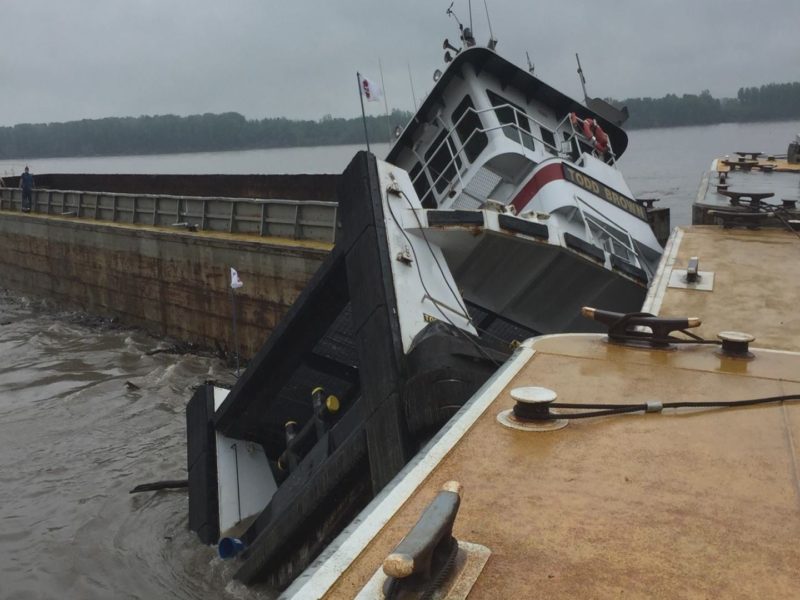While attempting to maneuver a string of barges, an experienced Mississippi River towboat pilot underestimated the effect of current during high water, resulting in the collision and sinking of the Todd Brown, according to the National Transportation Safety Board.
No one was injured in the mid-afternoon accident on April 17, 2017. The sinking of the Ingram Barge Co. towboat near Columbus, Ky., resulted in $1.5 million in damage, and was a reminder of the perils of fleeting operations during flood stages.
Melting snow and spring rains had brought historic water levels to the river. On the day of the accident the river gauge at Cairo, Ill., measured about 36’ – almost 4' higher than normal – and was expected to crest to 48.5’. The current had reached an estimated 8 mph in the area of the accident, and the Coast Guard had already established an incident command to provide response efforts to flooded communities along the Mississippi River and issue tow-size restrictions for vessels in the area.

The towboat Todd Brown after its raising in April 2017. Coast Guard photo.
The 80’x28’, 1,800-hp Todd Brown was working in an Ingram fleeting area on the right side of the river along with the 74’x26’, 1,020-hp Ot Adkins, repositioning empty barges and de-drifting – flushing accumulated debris around the barges.
Preparing for one such operation around 3 p.m. on the day of the accident, the crews doubled all fore and aft couplings between four barges. The pilot of the Todd Brown faced up his towboat to the aft end of the string, while the Ot Adkins was positioned along the starboard side of the lead barge.
A narrative in the NTSB report tells what happened next.
“The pilot of the Todd Brown then began to maneuver his towboat to reposition the head of the barge string into the river. As the head of the barge string moved out into the river, a larger area of the barge string’s profile was exposed to an estimated 8-mph current. Despite having its engines at full ahead, the Todd Brown, along with the string of four barges, began moving astern.”
The pilot of the Todd Brown asked the other towboat crew to attach a line to one of the barges, and push the string back toward the shoreline and away from the strong current.
“However, as the current continued to overwhelm both towboats, the pilot directed a crewmember on board the Todd Brown to unface (disconnect) their towboat from the barge string. Once it was unfaced, the pilot maneuvered his vessel to the port side of the drifting barge string, toward the more shallow west bank of the river.”
The Todd Brown became trapped behind the moving string of barges, and collided with the lead barges of another fleet about 250’ downriver. With its port side pinned against the bow of a barge, the towboat began to list to starboard with the force of the current.
The pilot sounded the general alarm, and all six of the crew climbed onto the moored barges. The towboat swamped and finally sank in about 35’ of water.
The Todd Brown was raised five days later, and just 100 gals. Only 17,900 gals. of fuel on board escaped and it was captured by a containment boom. Refloated and drydocked for inspection, the Todd Brown’s hull was found to be undamaged, “but the wheelhouse structure was distorted, handrails and decks were bent, and all interior spaces were “water damaged, amounting to an estimated $1.5 million in repairs,” the NTSB report noted. There was no damage to the Ot Adkins or to any barges.
“The pilot had worked for Ingram for 17 years and was credentialed as master of towing vessels on Western Rivers,” according to the report. “Previously, he worked as a steersman from January 2011 to December 2012, and from then he was working as a fleet boat pilot until the time of the accident.
The pilot had engaged in fleeting operations during numerous times of high water and heavy drift conditions on the river, NTSB investigators found. The Todd Brown’s captain, who held the same credentials as the pilot, was off watch and in his bunk at the time of the accident, the NTSB reported.
Both towboats exceeded Coast Guard minimum-horsepower recommendations for moving barges in high water, but their power was not enough to handle the 8-mph current on the port side of the barge string. Investigators concluded the accident was triggered by “the pilot’s underestimation of the effect of the river current on the barge string being maneuvered during a de-drifting operation.”
---




